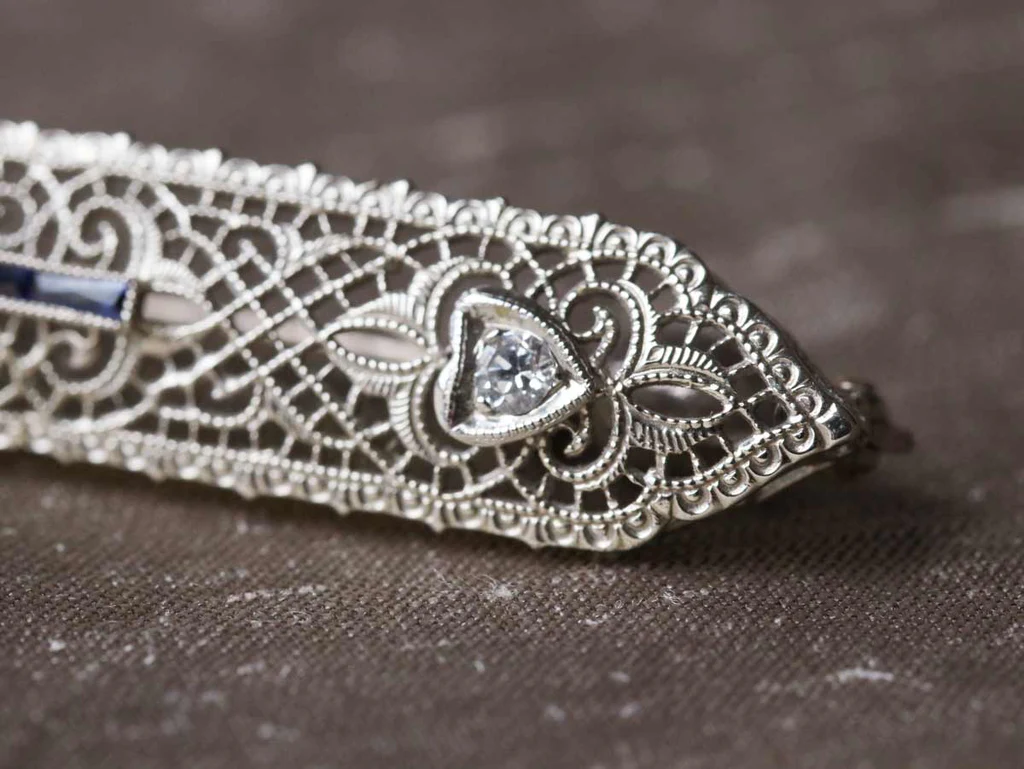
Image source; The Royal Collection Trust
During the short reign of King Edward VII from 1901-1910, the Edwardian era was born. Known for lavish and luxury, the King’s frivolity had a major influence on jewellery styles. There was a huge demand for elaborate jewellery as the king was known for hosting regular events and parties, as well as having an exceptionally OTT coronation.
In Edwardian society, it was common for the wealthy to display their riches through their materialistic purchases.
An overriding style of jewellery from the Edwardian era is luxe designs. Handcrafted techniques were favoured over the previous Victorian styles produced from the industrial revolution. Long-lasting materials such as diamonds and platinum were the first choice for materials due to their value. Platinum was favoured due to its lightweight yet strong properties, to be made into delicate pieces featuring techniques such as filigree. Diamonds were widely available so also more affordable, with diamond mining really booming in this era. It was common to find multiple diamonds and cuts in individual pieces due to new gemstone cuts constantly evolving.

A lot of the jewellery was very feminine, this time era fell within the Art Nouveau and Arts and Crafts movements, which had a heavy influence on the design of jewellery. Bows, florals, lace, and frills were motifs across all jewel styles making this time a very romantic era for jewellery.
Pearls were worn as a symbol of status during the Edwardian era. At the time they were more valuable than diamonds, with the size and quality being an indicator to how wealthy the person wearing them was. Those at the top of the wealth pyramid would wear jewellery that featured both pearls and diamonds.
Filigree

Image source; Market Square Jewellers. An example of open work filigree, made using platinum.
Whilst the technique of filigree was first created in around 5,000BC in Mesopotamia and Ancient Greece, the Edwardians really pulled it into popularity due to its extensive technique and lavish appearance. It’s a form of intricate metalwork, where delicate pieces of metal wire are twisted and manipulated into a design. It can be achieved with an open back so that the metal design sits open, or the wire designs can be metal supported where a sheet of thin metal is used as a backing, this is often used for more intricate filigree pieces to add support to the intricate design.
Edwardian Ladies

Image source; victorian-era.org.
A big stylistic change from Victorian to Edwardian jewellery is the neckline of a woman. The Victorians were seen as quite conservative, so the Edwardian ladies brought plunging and revealing necklines to their gowns. Dog collars and chokers with large pendants were a hugely popular style, quite often a ribbon would be used to thread a large pendant or even a brooch. These would be large in style, worn layered with various lengths to fill the open neckline.

Image source; Left - Katie Callahan & Co. Queen Alexandra of Denmark adorning multiple necklaces, including a choker-style collar. Right - Charlie Luxe Vintage. Two examples of lavalier style pendants and brooches.
The double pendant lavalier necklace was another popular style of necklace, a pendant would often feature a small gemstone hanging from the base which made good use of the much lower necklines.

Image source; Charlie Luxe Vintage. Impressive Edwardian 18ct Gold Diamond & Tourmaline Cluster Ring
Rings were also an equally popular jewellery item. Made predominately from platinum and diamond but would often feature a halo of diamonds to surround a gemstone. It’s this halo or cluster style which today is a very popular design to wear as an engagement ring, with the gemstone in the centre often being significant to the wearer. Due to the high availability of diamonds, they quickly became the stone to have for an engagement ring.
Whilst the Edwardian era was one that was short, it still had major influence on future jewellery styles which still remain timeless today. After King Edward VII died in 1910, many believe that the Edwardian era still continued until 1919, when design styles really shifted due to the First World War and the beginning of the Art Deco era.
Our favourite jewellery style to come from the Edwardian era is undoubtably the halo and cluster rings. Would you choose an Edwardian ring as your engagement ring? Let us know in the comments below!
